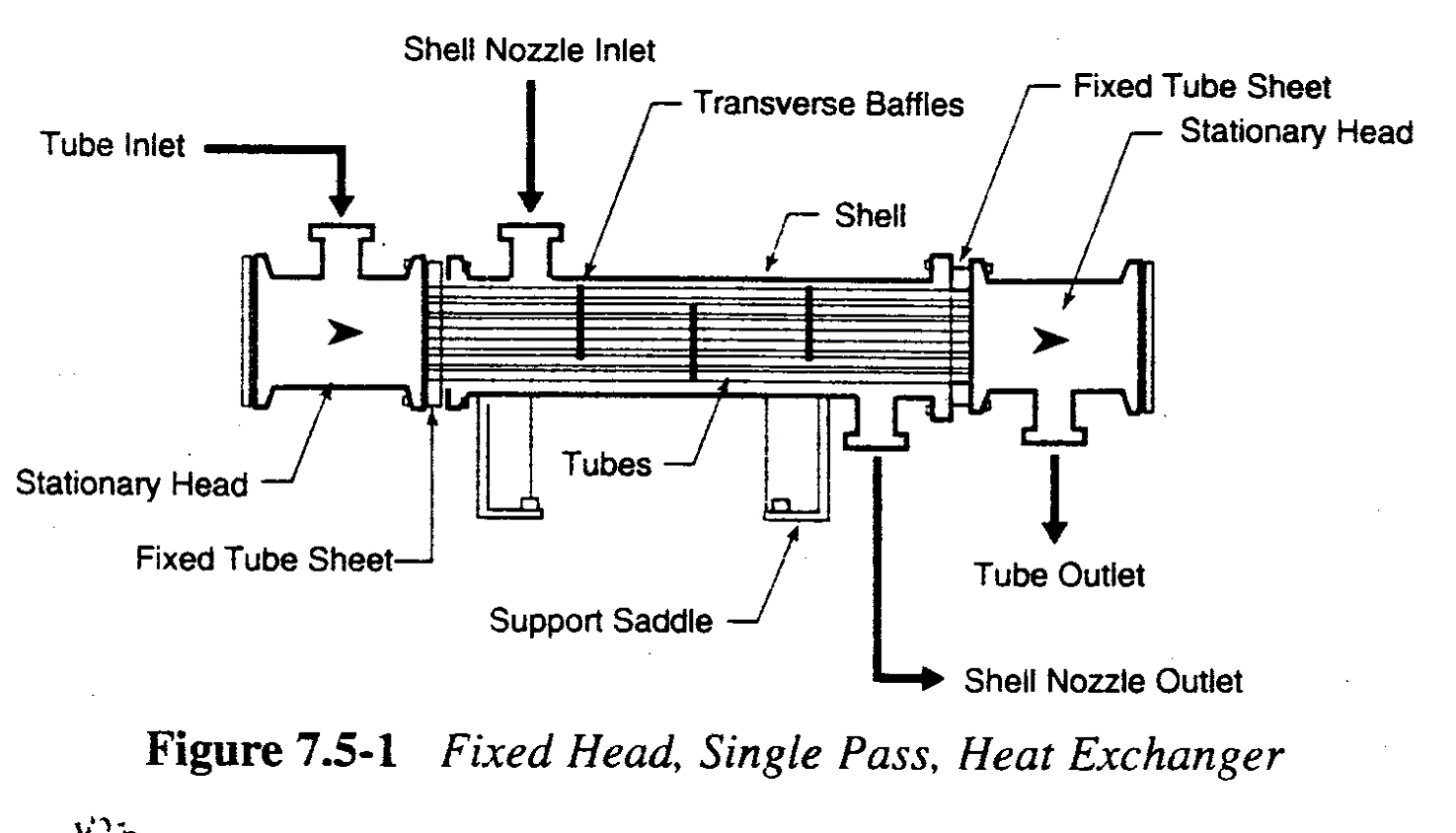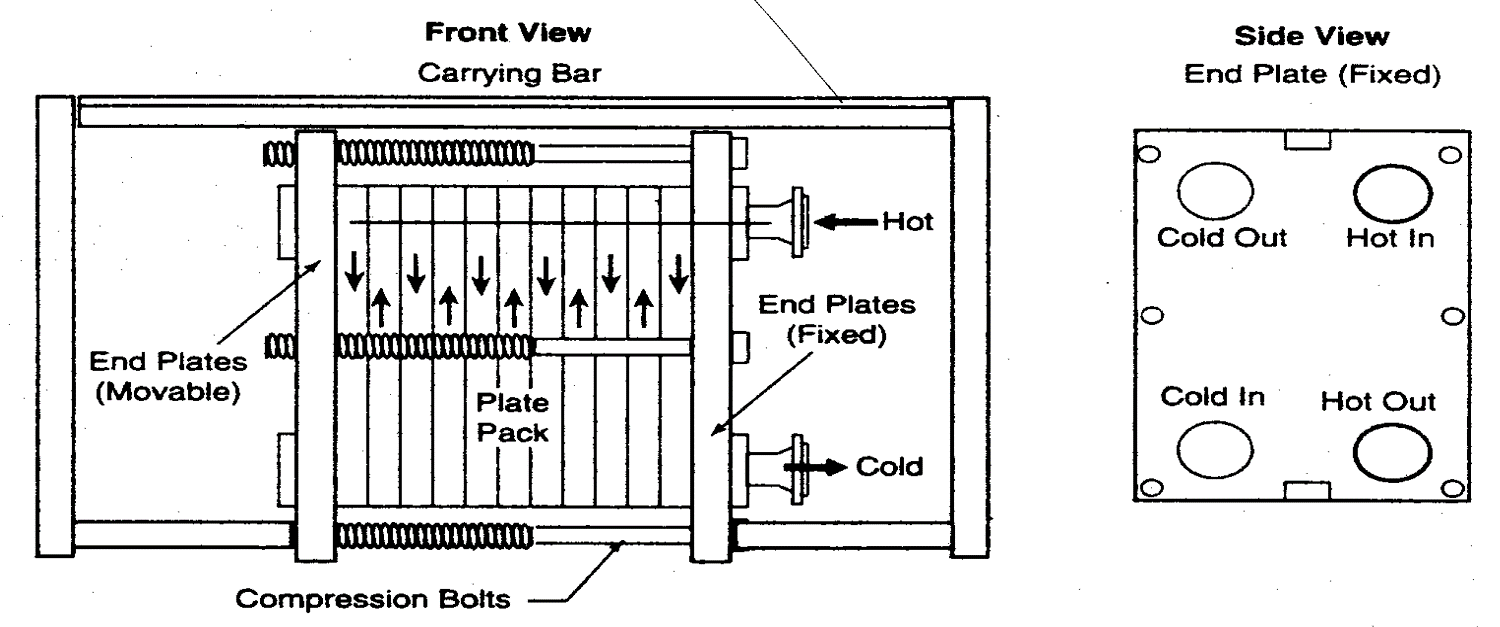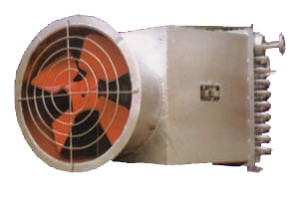Heat Exchanger
1.) Introduction
2.) Heat Transfer and Fluid Flow
3.) Types of Heat Exchangers
4.) Heat Exchangers and Systems
5.) Summary
1.) Introduction
Heat transfer is an important function of many industrial processes.
Transfer heat from one process to another.
2.) Heat Transfer and Fluid Flow
- Conduction
- Convection
- Radiant
- Laminar
- Turbulent
1.) Conduction:-
Heat energy is transferred through solid objects
Molecules absorb heat energy from a hotter source and then vibrate, so transfer the energy from the hot side to the cooler side
What is more, there are free electrons moving in the metal, so metal have better capability of conduction
2.) Convection:-
Convection occurs in fluids when warmer molecules move toward cooler molecules
The movement of the molecules sets up currents in the fluid that redistribute heat energy
The result is that the energy is equally distributed
3.) Radiant Heat Transfer:-
Heat is conveyed by electromagnetic waves
Radiant heat transfer is a line-of-sight process
Radiant heat transfer is not used in a heat exchanger
4.) Laminar Flow:-
Liquid flowing are in parallel fashion
Laminar flow usually exists at low flow rate
Laminar flow promotes the development of static film, which acts as an insulator
5.) Turbulent Flow:-
Turbulent flow is random movement or mixing of fluids
Turbulent flow allows molecules of fluid to mix and absorb heat more readily than does the laminar flow
Turbulent flow decreases the thickness of static film, increasing the rate of heat transfer
3.) Types of heat exchangers
- Double-pipe heat exchanger
- Shell and tube heat exchanger
- Plate and frame heat exchanger
- Spiral heat exchanger
- Pipe coil exchanger
- Air-cooled heat exchangers
1.) Double-pipe heat exchanger:-
A double-pipe exchanger has a pipe inside a pipe
The outside pipe provides the shell. And the inner pipe provides the tube
The warm and cool fluids can run parallel flow or counter current, because it is more efficient
Flow rates are very low in a double-pipe heat exchanger
The chemical processing industry commonly uses hairpin heat exchangers
Hairpins are typically rated at 500psig shell side and 500 psig tube side
Fins can be added to the internal tube’s external wall to increase heat transfer
Advantages:
Its excellent capacity for thermal expansion
It is easy to install and clean
Its modular design makes it easy to add new sections
Replacement parts are inexpensive and always in supply
Disadvantages
It is not as cost effective as most shell and tube exchangers
it requires special gaskets
2.) Shell and Tube Heat Exchangers
The shell and tube heat exchanger is the most common style found in industry
As the tube side flow enters the exchanger, flow is directed into tubes that run parallel to each other. these tubes run through a shell that has a fluid passing through it
Heat energy is transferred through the tube wall into the cooler fluid
Heat transfer occurs primarily through conduction and convection
A.) Shell and Tube Heat Exchanger—Shell
In most cases, the shell is designed to withstand the greatest temperature and pressure condition
The shell is the largest single part of the heat exchanger
The shell can be classified as single-pass, double-pass, split flow, double split flow, divided flow, cross-flow
B.) Shell and Tube Heat Exchanger—Tube
Tube can be plain or dinned
Plain tubes are commonly used in fabrication
Finned tube are starting to make an impact, fins can be located externally or internally
Tube materials include brass, carbon, …
C.) Shell and Tube Heat Exchanger—Tube Sheet
Tube sheets are often described as fixed or floating, single or double
Tube sheets have carefully drilled hole, the ends of the tubes in a heat exchanger are fixed by rolling, welding, or both
Double tube sheets are used to prevent tube side leakage of highly corrosive fluids
Engineering specifications take into account thermal tube expansion
If the tube sheet is welded or bolted to the shell, it is called fixed
If the tube sheet is independently secured to the tube head and is allowed to move freely inside the shell, it is called floating
D.) Shell and Tube Heat Exchanger—Baffle
Baffles provide the framework to support and secure the tubes and prevent vibration
The baffle layout increases or decreases fluid and directs flow at specific points
Tube side baffles are built into the heads to direct tube side flow
In multi pass exchangers, cost goes up with each pass, provide adequate fluid velocities to prevent fouling and to control heat transfer
E.) Shell and Tube Heat Exchanger—Tie Rod
Tie rods and concentric tube spacers keep the baffles in place and evenly spaced
Each hole in the baffle plates is 1/64” larger than the tube’s outside diameter
F.) Shell and Tube Heat Exchanger—Nozzles and Accessory Part
Nozzles and accessory part
Inlet and outlet nozzles are sized for pressure drop and velocity considerations
Thermowells, pressure indicator connections, safety and relief valves, product drains, vents, block valves and control valves
G.) Shell and Tube Heat Exchanger—Fixed Head
In a fixed head, single pass shell and tube heat exchangers, the tubes are connected to two tube sheets which are firmly attached to the shell
in the multi pass Shell and tube heat exchangers, the baffle added to the channel head and the lack of a tube side outlet on the discharge head
Temperature differential is less to 200℃
H.) Shell and Tube Heat Exchanger—Floating Head
One side of the tube bundle is fixed to the channel head, the other side is unsecured
Floating head exchangers, with their high cross-sectional areas(fins), are designed for high temperature differentials and high flow rate, produces the highest heat transfer efficiency
I.) Shell and Tube Heat Exchanger—U-Tube
The tube sheet connects a series of tubes bent in a U shape, the ends of the tubes are secured to the tube sheet
The total number of tubes is limits
Large temperature differentials
3.) Plate and Frame Heat Exchanger:-
It consist of a series of gasketed plates, sandwiched together by two end plates and compression bolts
Plate and Frame Heat Exchanger
Easy to disassemble and clean and distribute heat evenly so there are no hot spots
Plates can easily be added or removed
Low fluid resistance time, low fouling, high heat transfer
4.) Spiral Heat Exchanger:-
Spiral heat exchangers are characterized by a compact concentric design that generates high fluid turbulence
Type 1: spiral flow on both sides
Type 2: spiral flow-cross-flow
5.) Pipe Coil Exchanger:-
Pipe coils are submerged in water or sprayed with water to transfer heat
This type of operation has a low heat transfer coefficient and requires a lot of space
6.) Air-Cooled Heat Exchanger:-
Air-cooled heat exchangers provide plain or dinned tubes connected to an inlet and return header
Air is used as the outside medium to transfer heat away from the tubes
Fans are used in a variety of arrangements to apply forced convection for heat transfer coefficients
Provides a 40℃ temperature differential between the ambient air and the exiting process fluid
Air-Cooled Heat Exchanger
simple to construct and cheaper to maintain
Cannot fouling or corrosion
Low operating costs and superior high temperature removal
Limited in use
High outlet fluid temperature and high initial cost of equipment
In cases of loss of containment, they would be fire or explosion
4.) Heat Exchangers and Systems
Heat Exchangers and Systems—Parallel and Series Flow
in series flow, the tube side flow in a multi pass heat exchanger is discharged into the tube side flow of the second exchanger
In parallel flow, the process flow goes through multiple exchangers at the same time
Heat Exchangers and Systems—Cooling Towers
The system consists of a cooling tower, heat exchanger, pump
Cooling water is pumped into the shell side of a heat exchanger and returned (much hotter) to the top of the cooling tower
5.) Summary
The methods of heat transfer are conduction, convection, and radiation
The fluid flow are laminar and turbulent
The best conditions for heat exchangers are large temperature difference, high heating or coolant flow rates, large cross-sectional area of the exchanger, and others, so which heat exchanger is choose, it depends.

















